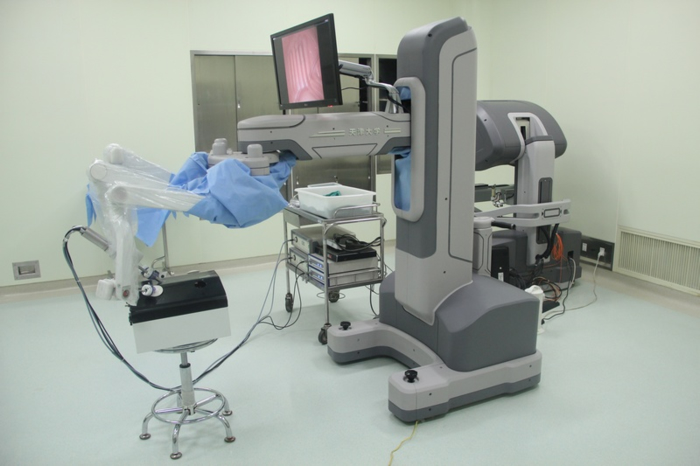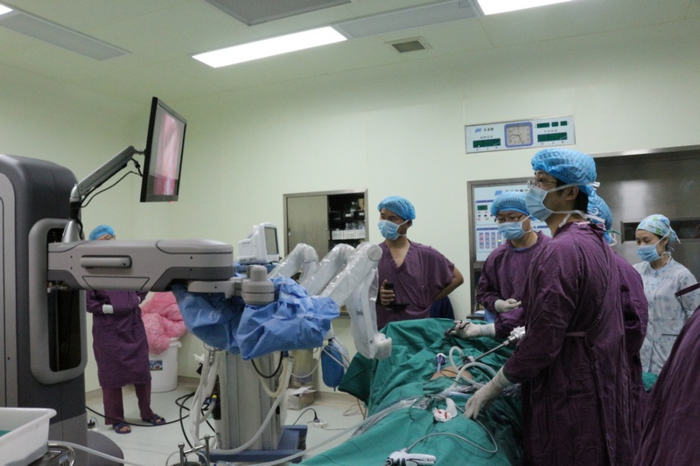
Press Conference

TJU "Micro Hand S" Robot

Robotic Surgery
The minimally invasive surgery (MIS) robot system “Micro Hand S”, invented by Tianjin University (TJU) with independent intellectual property rights, was recently used to perform surgery on three Changsha patients. This success indicates the official opening of the next stage of clinical trials for the robot, with hopes for mass production within the next three years.
The announcement was made April 4, 2014 at a press conference held by the Third Xiangya Hospital of Central South University. Wang Shuxin, project director and Dean of TJU School of Mechanical Engineering, was invited to attend.
The robotic surgeries were performed on March 26, March 31, and April 2 at the Third Xiangya Hospital of Central South University, and consisted of gastric perforation repair and an appendectomy.
The application of robot technology in MIS improves the doctor’s ability to operate, as he is able to sit at an operation desk and perform with a robotic hand. It also raises the standard of the operation, as the robot’s vision, accuracy, and precision is improved. The robot also has the capacity for remote operation. It is of great significance for the development of MIS.
According to Wang, the application of robotics in MIS surgical procedures is still a blank slate in China. The "Da Vinci robotic surgery system" developed by the U.S. is the first surgical robot in the world to be applied in operations of general surgery, cardiac surgery, urology, gynecology and obstetrics, which gives it a very monopolistic position. Importing such equipment would cost about 20 million RMB, which is a large waste of resources. This domestically developed “Micro Hand S” system is significantly cheaper. Additionally, the development of the robot system carries extensive technological significance.
According to Wang, there are three specific ways that this robot is superior to other foreign surgical robots. First, it has a finer and more independent cable transmission, which is capable of being fixed, and slip resistant, and will not come loose. This gives it better precision and longer life. Second, the position and sensitivity of the robot can be adjusted from the operation board according to the doctor’s requirements - for example, making the robot's “arms” lighter and more suitable to the needs of the operation. Third, they have used a different form of isomorphic control modeling technology, which enables more accurate hand - eye - instrument motion consistency in a three-dimensional (3D) visual environment.
The surgical robot ‘Micro Hand S’ far surpasses the limits of the human hand. Its mechanical arm can rotate and swing freely within 360 degrees. The operation is more detailed and accurate. The camera lens used on the inside of the human body is far more detailed than any human eye, giving up to ten times more detail and precision. The advanced 3D imaging technology makes the surgery location more accurate. Doctors can receive data about the patients through virtual haptic feedback sensitivity technology at any time, and adjust the robotic scheme to meet their needs. The operation doctor can complete the surgery merely through the computer remote control, without the help of many doctors.
Compared with the first generation of open stomach and chest surgery, and the second generation of laparoscope MIS, robotic surgery has added the following advantages. First, there are intuitive 3D imaging systems, improving the field and scope of vision. Second, there are wrist-simulation instruments with seven degrees of freedom, improving the precision and accuracy of operation dramatically. Third, the operators are able to perform surgery from a sitting position, enabling them to perform longer or more complex surgeries without getting as tired.
In foreign developed countries, the use of robotic systems is already commonplace for surgeries, gastrological and gynecology operations, chest and heart operations, etc. They have found broad uses and achieved great success. Robotic surgery is truly the new developmental direction in the field of MIS and is becoming the preferred method of surgical treatment of diseases.






